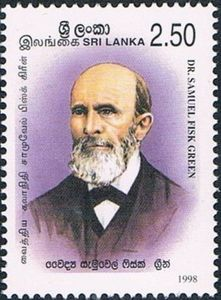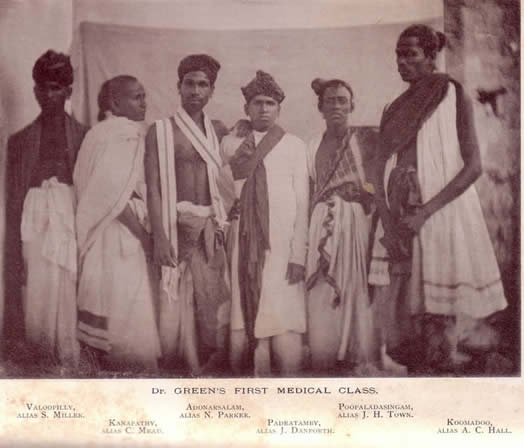Samuel Fisk Green: Medical Pioneer in South Asia

Two years after graduating from the College of Physicians & Surgeons in 1845, Samuel Fisk Green arrived in Jaffna in northern Sri Lanka (then Ceylon), where he spent the next 26 years providing medical care to the missionaries who worked there—and “locals who requested care.”
He also opened the first medical school in Ceylon, and on the occasion of the school’s 150th anniversary in 1998, Sri Lanka issued a stamp honoring Dr. Green’s contributions.

“The hospital he started still exists and is named Green Memorial Hospital,” says Dr. D.C. Ambalavanar, a visiting lecturer in surgery at the University of Jaffna. “I worked there once as a junior doctor and my mother was medical superintendent there for many years.”
When Dr. Green started a medical school in Manipay, the people there—Tamils—knew little of Western medicine. A 150th anniversary speech about Dr. Green given by Dr. N. Sivarajah noted that his intention in educating locals in medicine was to “popularize Western medicine among local people and wean them from indigenous practices which were injurious to health.”
The school’s first three students in 1848 were hand-picked from a local seminary for a three-year medical course based on American medical school curricula. During the 26 years Dr. Green was in Jaffna, he had trained 87 doctors, some in English and others in the Tamil language.

He expected graduates to remain in Jaffna to serve the local people in the villages, but demand for the graduates was high and many obtained jobs in the government or moved to other parts of Sri Lanka. Some also moved to India and Malaya.
In an effort to stem this exodus, Dr. Green started teaching in Tamil. No Tamil books existed on Western medicine, so he translated English medical books into Tamil. This included major textbooks (“Gray’s Anatomy” and “Dalton’s Physiology,” for example) and several original treatises on general health, cholera, and parts of the body.
His translation of “Cutter’s Anatomy, Physiology and Hygiene” (2nd edition) was printed locally in Manipay. When news of his translations spread to South India, he received orders for 134 copies of the textbook from Thirunelvely in South India. Dr. Green’s translations resulted in 4,500 pages of works in Tamil.
Two Tamil medical students helped him with the translations. One of those students, Joshua Danforth, was among the first class of students at the medical school. He later received an honorary MD degree from P&S on Dr. Green’s recommendation. Dr. Danforth succeeded Dr. Green as medical superintendent of the Manipay hospital.
At the request of the British government, Dr. Green helped establish the Friend-in-Need Society Hospital in Jaffna and was the first visiting surgeon there. The hospital is now the Teaching Hospital and the leading government hospital in the north of the country. From 1850 to 1907, the medical staff of the Friend-in-Need Society Hospital were drawn almost totally from the graduates of Dr. Green’s medical school.
Dr. Green’s papers were discovered a few years ago by his descendants in a storage warehouse. His Tamil translations of Western medical works, including the physiology textbook by Columbia’s John Dalton, were acquired by the UCLA library.
Dr. Green was born in Massachusetts. His brother, Andrew Haswell Green, was a New York City planner, lawyer, and civic leader sometimes called “the Father of Greater New York” for his work on Central Park, the New York Public Library, the Bronx Zoo, the American Museum of Natural History, and the Metropolitan Museum of Art, and other projects throughout New York City.
The Manipay medical school closed in 1879, and Dr. Green died in Massachusetts in 1884. His will asked that his gravestone be plain and simple and include these words: “medical evangelist to the Tamils.”
- Log in to post comments

